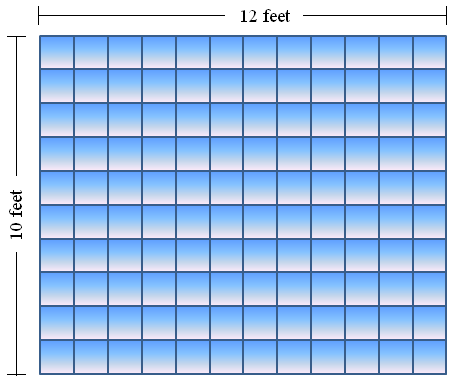Introduction to the Concept of Area
Suppose a room floor with length 12 feet and width 10 feet shown in Figure 2 is to be tiled using of a 1 foot by 1 foot tile shown in Figure 1, then it is clear 120 tiles are needed.
Figure 1 – A square representing a tile measuring 1 foot by 1 foot.
There are cases, of course, that some tiles have be to cut due to the size restriction of the room. For instance, How many 1 foot by 1 foot tile do we need to cut to cover a floor of a room measuring 10.5 by 12.5 feet? How many tiles are needed to cover the entire floor?
To explore more, click the here to open the GeoGebra applet and answer the questions following the applet.
Figure 2 – Tiles covering a room with length 12 ft and width 10 ft.
From the GeoGebra applet questions above, it is clear that the number of tiles that can cover an entire room is the product of its length and its width, whether the tiles are cut or not. The number of square feet (tiles in our problem) that covers the room is what we call its area. Therefore, we can think of area as the number of square units that entirely covers a bounded region – square units because we can always choose the units that we will use. For example, I can choose meter as unit instead of feet in the problem above.
Hence, we can say that the area of a room measuring 10 feet by 12 feet is 120 square feet. Generalizing, if we let L be the length of the rectangle and W its width and A its area, we can conclude that A = L x W.
If the length and the width of the rectangle are equal, then the rectangle is a square. If we let S be the side of the square, then A = S x S or A = S2.
Of course, not all figures are rectangles or squares. There are curves and irregular figures. Don’t worry, we will discuss them in the future. This is just the start of the Area Tutorial Series.

